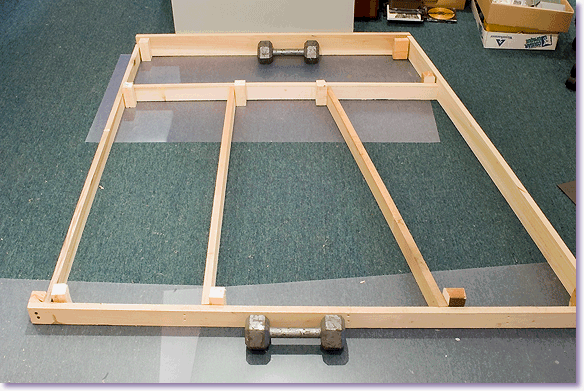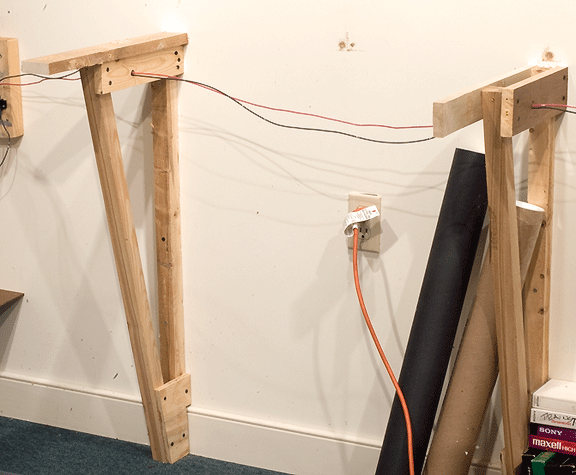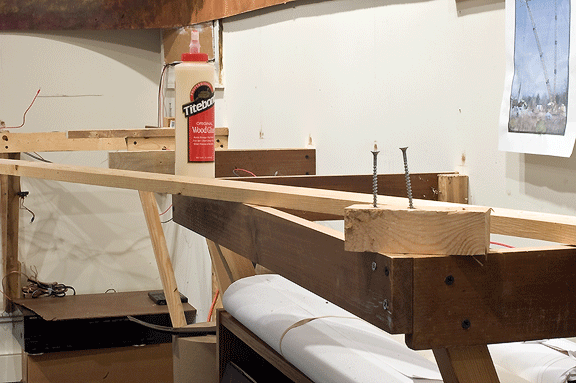January 2007
Placing the Peninsula
19/01/07 11:34 Filed in: Benchwork
Much of the space in the train room will be occupied by the peninsula which carries the railroad on a long loop.

The peninsula is an odd shape, which complicated cutting the pieces and joints. AND I laid it out on the floor to assemble upside down, which really strained my spacial conception capabilities.

Once the peninsula was assembled, I propped it up in position. I carriage bolted it to the existing benchwork. Legs were clamped in position, and diagonal braces were cut, glued and screwed in position.

Junk immediately began to accumulate under the peninsula as soon as it was in place.

The peninsula is an odd shape, which complicated cutting the pieces and joints. AND I laid it out on the floor to assemble upside down, which really strained my spacial conception capabilities.

Once the peninsula was assembled, I propped it up in position. I carriage bolted it to the existing benchwork. Legs were clamped in position, and diagonal braces were cut, glued and screwed in position.

Junk immediately began to accumulate under the peninsula as soon as it was in place.
From Old to New
07/01/07 12:45 Filed in: Benchwork
With the backdrop completely repainted, all that remains of my old HO scale layout is the brackets for the benchwork.
I am starting the New Year by modifying the brackets. My old benchwork was built in separate sections of box framing. The sections merely sat on the brackets along the wall, being connected to each other, but not connected to the support brackets or to the wall itself. I thought this might prevent stress and possible buckling on the layout by allowing it to "float" in the space. In practice this turned out to not be a good design. Sitting on widely spaced brackets did not provide enough support for the sectional benchwork, and the sections tended to warp or twist over time.

The first modification to the old brackets was to lengthen or shorten them as necessary to fit the depth of the new benchwork. I either cut the brackets, or added longer joists to the existing bracket depending on the situation.

I then added a stringer across the ends of all the brackets to tie them together on the front. The position of the front stringer reflects the eventual depth of the benchwork in that particular area.

Then I added another stringer connecting the backs of all the brackets, near the wall.

The addition of the two stringers to all the brackets increased the strength of each individual bracket, but more importantly increased the amount of bearing surface to support the new benchwork.
I am starting the New Year by modifying the brackets. My old benchwork was built in separate sections of box framing. The sections merely sat on the brackets along the wall, being connected to each other, but not connected to the support brackets or to the wall itself. I thought this might prevent stress and possible buckling on the layout by allowing it to "float" in the space. In practice this turned out to not be a good design. Sitting on widely spaced brackets did not provide enough support for the sectional benchwork, and the sections tended to warp or twist over time.

The first modification to the old brackets was to lengthen or shorten them as necessary to fit the depth of the new benchwork. I either cut the brackets, or added longer joists to the existing bracket depending on the situation.

I then added a stringer across the ends of all the brackets to tie them together on the front. The position of the front stringer reflects the eventual depth of the benchwork in that particular area.

Then I added another stringer connecting the backs of all the brackets, near the wall.

The addition of the two stringers to all the brackets increased the strength of each individual bracket, but more importantly increased the amount of bearing surface to support the new benchwork.
